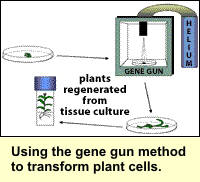 |
The modified gene is now ready for the fourth step in the process, transformation or gene insertion.
Since plants have millions of cells, it would be impossible to insert a copy of the transgene into every cell. Therefore, tissue culture is used to propagate masses of undifferentiated plant cells called callus. These are the cells to which the new transgene will be added.
The new gene is inserted into some of the cells using various techniques. Some of the more common methods include the gene gun, agrobacterium, microfibers, and electroporation.  The main goal of each of these methods is to transport the newgene(s) and deliver them into the nucleus of a cell without killing it. (For example, the gene gun method of transformation shoots gene-coated, microscopic gold particles at plant cells to deliver the DNA into the nucleus. Transformed plant cells are then regenerated into transgenic plants.) The main goal of each of these methods is to transport the newgene(s) and deliver them into the nucleus of a cell without killing it. (For example, the gene gun method of transformation shoots gene-coated, microscopic gold particles at plant cells to deliver the DNA into the nucleus. Transformed plant cells are then regenerated into transgenic plants.)
From there, the new DNA may or may not be successfully inserted into a chromosome. The cells that do receive the new gene are called transgenic and are selected from those that are not transgenic. Many types of plant cells are totipotent meaning a single plant cell can develop into an entire plant. Therefore, each transgenic cell can then develop into an entire plant which has the transgene in every cell. The transgenic plants are grown to maturity in greenhouses and the seed they produce, which has inherited the transgene, is collected. The genetic engineer's job is now complete. He/she will hand the transgenic seeds over to a plant breeder who is responsible for the final step.
 |









